Seungyeon Shin
Weighted Unsupervised Domain Adaptation Considering Geometry Features and Engineering Performance of 3D Design Data
Sep 08, 2023Abstract:The product design process in manufacturing involves iterative design modeling and analysis to achieve the target engineering performance, but such an iterative process is time consuming and computationally expensive. Recently, deep learning-based engineering performance prediction models have been proposed to accelerate design optimization. However, they only guarantee predictions on training data and may be inaccurate when applied to new domain data. In particular, 3D design data have complex features, which means domains with various distributions exist. Thus, the utilization of deep learning has limitations due to the heavy data collection and training burdens. We propose a bi-weighted unsupervised domain adaptation approach that considers the geometry features and engineering performance of 3D design data. It is specialized for deep learning-based engineering performance predictions. Domain-invariant features can be extracted through an adversarial training strategy by using hypothesis discrepancy, and a multi-output regression task can be performed with the extracted features to predict the engineering performance. In particular, we present a source instance weighting method suitable for 3D design data to avoid negative transfers. The developed bi-weighting strategy based on the geometry features and engineering performance of engineering structures is incorporated into the training process. The proposed model is tested on a wheel impact analysis problem to predict the magnitude of the maximum von Mises stress and the corresponding location of 3D road wheels. This mechanism can reduce the target risk for unlabeled target domains on the basis of weighted multi-source domain knowledge and can efficiently replace conventional finite element analysis.
Performance Comparison of Design Optimization and Deep Learning-based Inverse Design
Aug 23, 2023Abstract:Surrogate model-based optimization has been increasingly used in the field of engineering design. It involves creating a surrogate model with objective functions or constraints based on the data obtained from simulations or real-world experiments, and then finding the optimal solution from the model using numerical optimization methods. Recent advancements in deep learning-based inverse design methods have made it possible to generate real-time optimal solutions for engineering design problems, eliminating the requirement for iterative optimization processes. Nevertheless, no comprehensive study has yet closely examined the specific advantages and disadvantages of this novel approach compared to the traditional design optimization method. The objective of this paper is to compare the performance of traditional design optimization methods with deep learning-based inverse design methods by employing benchmark problems across various scenarios. Based on the findings of this study, we provide guidelines that can be taken into account for the future utilization of deep learning-based inverse design. It is anticipated that these guidelines will enhance the practical applicability of this approach to real engineering design problems.
Topology Optimization via Machine Learning and Deep Learning: A Review
Oct 19, 2022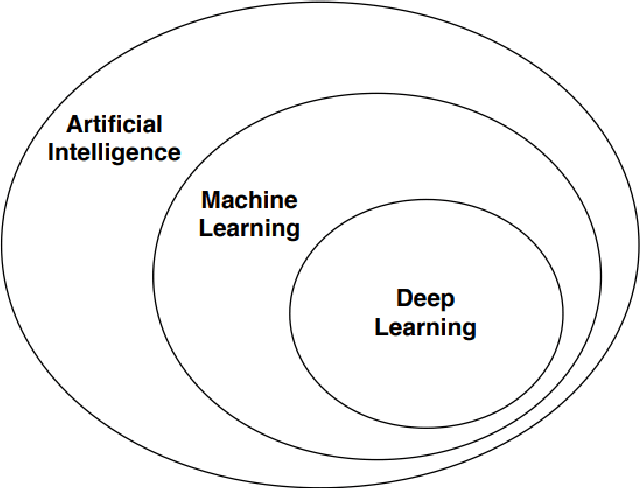
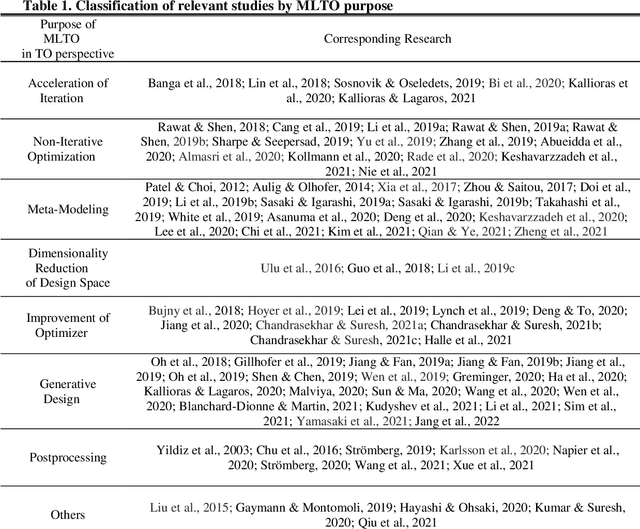
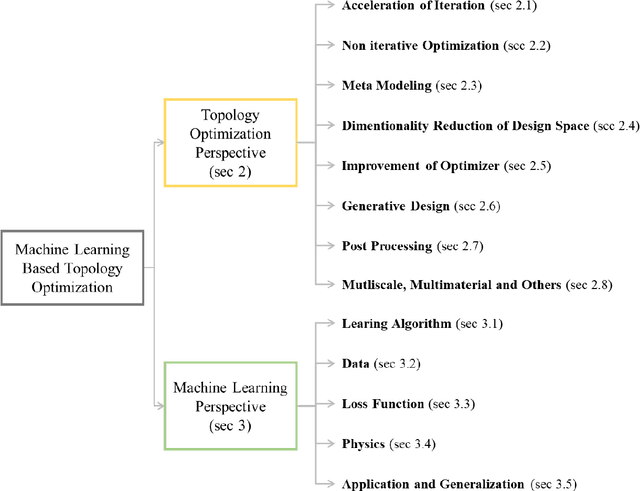
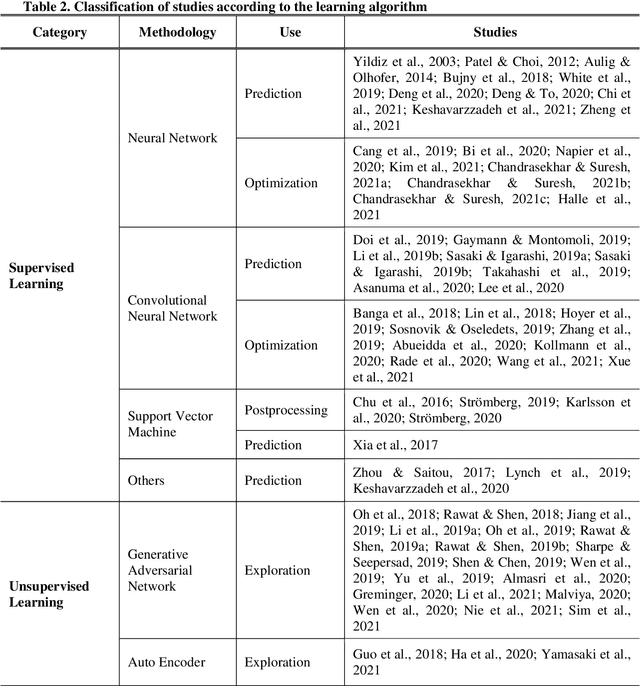
Abstract:Topology optimization (TO) is a method of deriving an optimal design that satisfies a given load and boundary conditions within a design domain. This method enables effective design without initial design, but has been limited in use due to high computational costs. At the same time, machine learning (ML) methodology including deep learning has made great progress in the 21st century, and accordingly, many studies have been conducted to enable effective and rapid optimization by applying ML to TO. Therefore, this study reviews and analyzes previous research on ML-based TO (MLTO). Two different perspectives of MLTO are used to review studies: (1) TO and (2) ML perspectives. The TO perspective addresses "why" to use ML for TO, while the ML perspective addresses "how" to apply ML to TO. In addition, the limitations of current MLTO research and future research directions are examined.
Wheel Impact Test by Deep Learning: Prediction of Location and Magnitude of Maximum Stress
Oct 03, 2022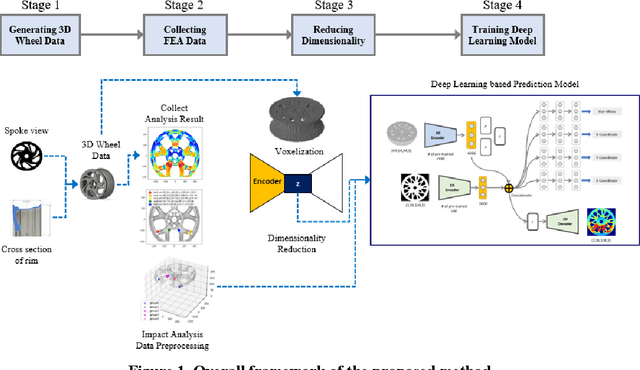

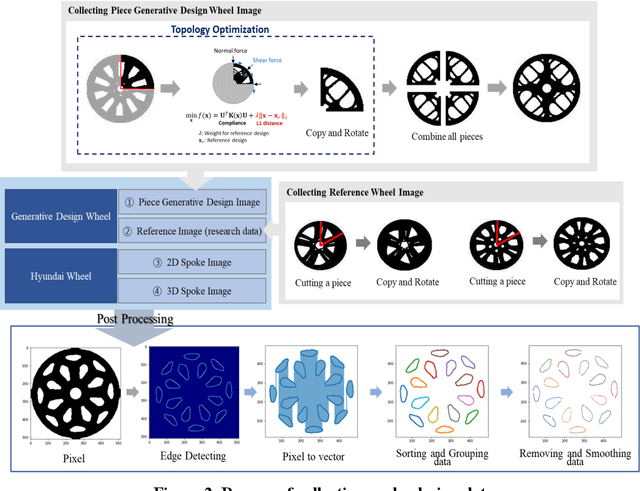

Abstract:The impact performance of the wheel during wheel development must be ensured through a wheel impact test for vehicle safety. However, manufacturing and testing a real wheel take a significant amount of time and money because developing an optimal wheel design requires numerous iterative processes of modifying the wheel design and verifying the safety performance. Accordingly, the actual wheel impact test has been replaced by computer simulations, such as Finite Element Analysis (FEA), but it still requires high computational costs for modeling and analysis. Moreover, FEA experts are needed. This study presents an aluminum road wheel impact performance prediction model based on deep learning that replaces the computationally expensive and time-consuming 3D FEA. For this purpose, 2D disk-view wheel image data, 3D wheel voxel data, and barrier mass value used for wheel impact test are utilized as the inputs to predict the magnitude of maximum von Mises stress, corresponding location, and the stress distribution of 2D disk-view. The wheel impact performance prediction model can replace the impact test in the early wheel development stage by predicting the impact performance in real time and can be used without domain knowledge. The time required for the wheel development process can be shortened through this mechanism.
 Add to Chrome
Add to Chrome Add to Firefox
Add to Firefox Add to Edge
Add to Edge